Epiphone
 | |
| Subsidiary | |
| Industry | Musical instruments |
| Founded | 1873 in Smyrna, Ottoman Empire (now İzmir, Turkey) |
| Founder | Anastasios Stathopoulos |
| Headquarters | Nashville, Tennessee, United States |
Area served | Worldwide |
Key people | Jim Rosenberg (President)[1] |
| Products |
Electric, acoustic, archtop & resonator guitars Basses Banjos Mandolins Amplifiers Effects units |
| Parent | Gibson |
| Subsidiaries | Dobro |
| Website | Epiphone.com |
Epiphone is an American musical instrument manufacturer founded by Anastasios Stathopoulos, currently based in Nashville, Tennessee. Epiphone is owned by Gibson Guitar Corporation and was Gibson's main rival in the archtop market prior to its acquisition in 1957.[2] Their professional archtops, including the Emperor, Deluxe, Broadway and Triumph, rivaled those of Gibson. Aside from guitars, Epiphone also made upright basses, banjos, and other stringed instruments. However, the company's weakness in the aftermath of World War II allowed Gibson to absorb it.[3]
The name "Epiphone" is a combination of proprietor Epaminondas Stathopoulos' nickname "Epi" and "phone" (from Greek phon-, "sound"/"voice").[4]
History
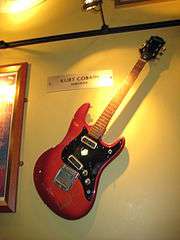
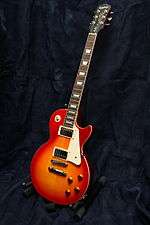

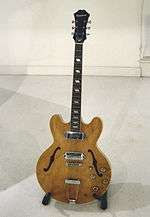
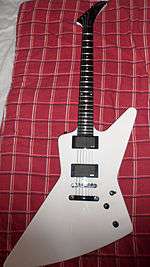
.png)
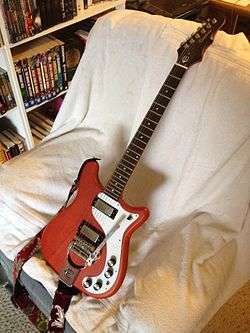

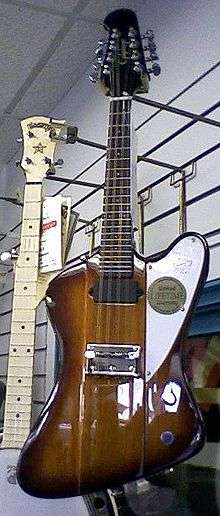
.jpg)
.jpg)
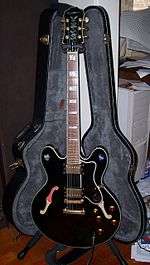
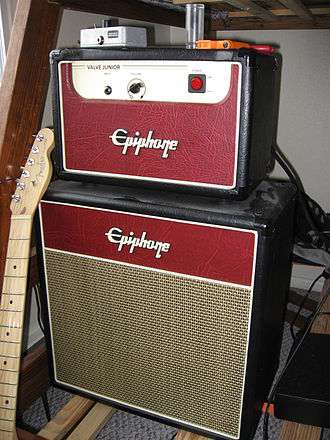
Epiphone began in 1873, in Smyrna, Ottoman Empire (now İzmir, Turkey), where Greek founder Anastasios Stathopoulos made his own fiddles and lutes (oud, laouto). Stathopoulo moved to the United States in 1903 and continued to make his original instruments, as well as mandolins, from Long Island City in Queens, New York. Anastasios died in 1915, and his son, Epaminondas ("Epi"), took over. After two years, the company became known as The House Of Stathopoulo.[5] Just after the end of World War I, the company started to make banjos. The company produced its recording line of banjos in 1924 and, four years later, took on the name of the Epiphone Banjo Company. It produced its first guitars in 1928. After Epi died in 1943, control of the company went to his brothers, Orphie and Frixo. In 1951, a four-month-long strike forced a relocation of Epiphone from New York City to Philadelphia. The company was acquired by its main rival, Gibson, in 1957.[6]
Instruments
Guitars
After Epiphone became a subsidiary of Gibson, many of its instruments were patterned after the more expensive Gibson versions. However, Epiphone also maintains its own line of archtop guitars.
As of January, 2013, Epiphone makes the following guitars:
Gibson Models
- B. B. King Lucille
- Dove / PRO
- EJ-200 Artist / 200CE (J-200)
- EL-00 / PRO (L-00)
- ES-335 PRO
- ES-339 PRO / 339 Ultra
- ES-345
- Explorer – 1984 EX / 1958 Goth
- Firebird TV-Silver
- Flying V – '58 Korina
- Flying-V – Jeff Waters Anihillation-V
- Flying-V – Robb Flynn Love/Death Baritone
- Hummingbird / PRO / Artist
- John Lennon EJ-160E
- Les Paul
- Les Paul-100
- Les Paul Baritone[7]
- Les Paul 1956 Goldtop
- Ace Frehley Budokan Les Paul
- Joe Bonamassa Goldtop
- Les Paul Black Beauty 3
- Les Paul Custom PRO / Blackback
- Les Paul Junior
- Les Paul Nightfall**
- Les Paul Prophecy EX & GX
- Les Paul Special II
- Les Paul Special Bass
- Les Paul Standard / Royale / PRO
- Les Paul Studio / Goth
- Les Paul Tribute
- Les Paul Traditional PRO
- Les Paul Ultra III / PRO
- Les Paul Ukulele
- Tak Matsumoto DC Standard & Custom Plus
- Zakk Wylde Custom Plus Bullseye
- Nighthawk Custom
- Nikki Sixx Blackbird
- SG
- Thunderbird-IV / Goth / PRO-IV / Classic-IV PRO
- Tom DeLonge ES-333
Original Epiphone models
- AJ-100 / 100CE
- AJ-220S / 220SCE
- Allen Woody Rumblekat
- Broadway
- Casino / 1961 50th Anniversary / Elitist / Inspired by John Lennon
- Century
- Dot / Dot Studio
- DR-100 & 212
- Dwight Trash Casino
- Emperor Swingster / Royale / Black Royale
- ET-270
- ET-275 Crestwood
- ET-276
- ET-280 Bass
- Graveyard Disciple
- Inspired by 1964 Texan
- Jack Casady Signature Bass
- Joe Pass Emperor II
- Masterbilt DR-500MCE
- Masterbilt EF-500RCCE
- MB-100 & 200 Banjo
- MM-20 / 30S / 50E Professional Mandolin
- PR-150
- PR-5E
- PR7E
- Riviera Custom P93
- Sheraton II / 1962 50th Anniversary / Union Jack Ltd Edition (inspired by Noel Gallagher)
- Sonador
- Supernova / Manchester City Blue / Union Jack
- SST Classic
- Triunfadora
- Viola Bass
- Wildkat / Royale
- Wilshire PRO / 1966 Worn / Phantomatic / II / III
Amplifiers
Epiphone began producing amplifiers in 1935 with the Electar Hawaiian Lap Steel Guitar Outfit. This outfit was an amplifier, case and lap steel guitar stand all rolled into one unit[8] and was supplied by a suitcase manufacturer of the time.
Gibson produced Epiphone amplifiers in the 1960s. These were basically copies or variations of Gibson and Fender amplifiers. They used a tube design, and some had reverb and tremolo. Gibson decided to launch a new line of Epiphone amplifiers in 2005 with many different models, including the So Cal, Blues Custom, and the Epiphone Valve Junior. The Valve Hot Rod and Valve Senior were released in 2009. The Valve Hot Rod is a 5 watt amp like the Valve Junior, but has a gain and reverb control. The Valve Senior offers 20 watts of power, with a full equalizer, gain, volume, reverb, and presence control.
As of 2012, Epiphone has ceased production of their line of amplifiers with the exception of the Player and Performance Pack practice amplifiers, available only in Epiphone's starter packages. These Amplifiers are under the Epiphone Electar moniker.[9]
Manufacturing
USA
Epiphone instruments made between 1957 and 1970 were made in the Gibson factory at 225 Parsons St and on Elenor St; Kalamazoo, MI 49007. Only solid guitars with flat tops and backs were made at the Elenor Street plant (both Gibson and Epiphone) in Kalamazoo, Michigan. These Epiphone instruments were effectively identical to the relevant Gibson versions, made with same timber, materials and components, and by the same people as the contemporary equivalent Gibson guitars. They shared the Gibson serial-number sequence.
Some specific examples of Gibson-made Epiphone instruments from this period includes the Epiphone Sheraton (co-developed with the Gibson ES-335 & sharing its semi-hollow body, but with, Epiphone's pre-Gibson "Frequensator" tailpiece and "New York" mini-humbucker pick-ups, and significantly fancier inlays) and Sheraton II (replacing the Frequensator with Gibson's "stop-bar" tailpiece), the Epiphone Casino (similar to the Gibson ES-330), the Epiphone Cortez (similar to the Gibson B-25), the Epiphone Olympic Special (similar to the Gibson Melody Maker), the Epiphone Sorrento (similar to the Gibson ES-125TC, except for a few cosmetic changes), and the Epiphone Texan (similar to the Gibson J-45, apart from a change in scale-length). The other Kalamazoo-made Epiphones had technical or cosmetic relationship with the similar Gibson version.
Several Epiphone guitars have been produced in the United States after 1971. The Epiphone Spirit and Special were produced in the early 1980s in Kalamazoo. In 1993, three historic Epiphone acoustic guitars, the Texan, Frontier, and Excellente, were produced by Gibson Acoustic in Montana. The Paul McCartney Texan was produced in 2005, and in 2009, the Epiphone Historic Collection was created, beginning with the 1962 Wilshire, built by Gibson Custom. Several other models, such as the Sheraton and John Lennon Casinos, were built in Japan and assembled and finished by Gibson USA.
Japan
In the early 1970s, Matsumoku began to manufacture Epiphone instruments in Japan[10] with the production and distribution being managed by Aria, in cooperation with Gibson. At this time, Epiphone ceased production of all of its traditional designs and began manufacturing markedly less expensive guitars, many of which had less traditional bolt-on style necks and unspecified wood types.[11] Some of these guitars had similar body shapes to traditional Epiphone and Gibson designs but had different names while other models retained certain model designations, such as the FT (Flat Top) guitars.[12] Construction of these guitars differed greatly from past Epiphone models. For the first several years of production in Japan, Epiphone guitars were actually rebranded designs already produced by the Matsumoku Company.[13]
By 1975, the Japanese market started seeing some of the more familiar designs and names being reintroduced. These guitars were of higher quality than that of the previous years of production in Japan and included models such as the Wilshire, Emperor, Riviera and Newport bass.[14] These models were available to the Japanese market only. By 1976 new designs of higher quality were being introduced for export but did not include the current Japanese market models. Notable new designs from this era were the Monticello (Scroll Guitar), the Presentation (PR) and Nova series flat tops and the Genesis solid body guitar. By 1980, most Japanese-only designs were available for worldwide distribution. The Matsumoku-made archtops, such as the Emperor, Riviera, Sheraton and Casino, were available into the mid-1980s.
Korea
From the 1980s, Epiphones were manufactured mainly in Korea and Japan by contractors licensed by Gibson.[10][15] One of these contractors was Samick,[15] which also built instruments under license for other brands and in its own name. The brand was primarily used to issue less expensive versions of classic Gibson models.[15]
These guitars were constructed using different woods (usually Nyatoh, for example, instead of Mahogany), were fastened with epoxies rather than wood-glues. Gibson and Epiphone guitars all use Titebond resin glue, which is simple carpenters' wood glue, and were finished in hard, quick-to-apply polyester resin rather than the traditional nitro-cellulose lacquer used by Gibson Epiphone guitars assembled or made in the US use lacquer finishes, but those made outside of the US use a poly urethane finish because of pollution requirements. These particular budget considerations, along with others such as plastic nuts and cheaper hardware and pickups, allow for a more affordable instrument.
Samick has stopped manufacturing guitars in Korea.
China
In 2002, Gibson opened a factory in Qingdao, China, which manufactures Epiphone guitars.[16] With few exceptions, Epiphones are now built only in the Qingdao factory.[16]
Unique Epiphone models, including the Emperor, Zephyr, Riviera and Sheraton, are built to higher quality standards than the company's "Gibson copy" line. In 2004 Epiphone introduced a series of acoustic guitars named Masterbilt after a line of guitars of the 1930s. Today's Masterbilt guitars are manufactured in Qingdao, China.[17]
Imperial Series and Elitist
During the early 1990s Epiphone released a series called the Imperial Series. These were remakes of the classic Epiphone archtops of the 1930s and '40s. Each instrument was handmade in the FujiGen factory in Japan. This short-lived series was discontinued in 1993, after only 42 Emperors were made. Several other models, including De Luxe, Broadway and Triumph models, were also produced in varying quantities.
Production was moved back to Nashville and Bozeman for a similar limited run of instruments (250 each of Sheratons, Rivieras, Frontiers, Excellentes and Texans).[18] These guitars were the "Nashville USA Collection" (archtops) and the "Anniversary Series" (acoustics). Contrary to popular information, this line was related to, but not part of the 1994 Gibson Centennial Series commemorating 100 years of the Gibson Guitar Corporation. The Nashville and Anniversary Collections were intended as reintroductions of original, USA built Epiphone models.
In 2002, Epiphone began producing a range of higher quality instruments under the "Elitist Series" moniker which were built by Terada and FujiGen in Japan. As of 2008, all of the Elitist models have been discontinued with the exception of the Elitist Casino and the Dwight Trash Casino. The Epiphone Elitist guitars included features such as higher grade woods, bone nuts, hand-rubbed finishes, "Made in the USA" pickups and USA strings.[19] Japanese domestic market Elitists used the Gibson Dove-wing headstock as opposed to the "tombstone" headstock used on exports.[20]
Serial numbers and factory codes
Current Epiphone serial numbers give the following information:[21]
Korea
- I = Saein
- U = Unsung
- S = Samick
- P or R = Peerless
- K = Korea
China
- MR=CHINA
- DW = DaeWon
- EA = Gibson/QingDao
- EE = Gibson/QingDao
- MC = Muse
- SJ = SaeJung
- Z = Zaozhuang Saehan
- BW = China
Japan
- No letter or F = FujiGen
- J or T = Terada
Czech Republic
- B = Bohêmia Musico-Delicia
Indonesia
- SI = Samick Indonesia
Example: SI09034853 SI = Samick Indonesia, 09 = 2009, 03 = March, 4853 = manufacturing number.
YYMMFF12345
- YY year
- MM month
- FF factory-code
- 12345 production#
- FACTORY NUMBER CODES—for some models starting in 2008, if serial # begins w/numbers
- [NOTE: The factories identified by these codes are based on patterns that forum members have observed. The numbers appear as the 5th and sixth digits in the serial number.]
- 11 = MIC sticker on a '08 Masterbilt
- 12 = DeaWon or Unsung (China—uncertainty remains as to which factory)
- 13 = Sticker: Made in China (Unknown factory; Epiphone LP-100)
- 15 = Qingdao (China) – electric
- 16 = Qingdao (China) – acoustic
- 17 = China – factory unknown MIC sticker on a J160E
- 18 = China – factory unknown found on one 2009 model bass
- 20 = DaeWon or Unsung (China—uncertainty remains as to which factory)
- 21 = Unsung, Korea
- 22 = ??? Korea (factory still unknown)
- 23 = ??? Indonesia (factory still unknown, probably Samick,)
- I = Indonesia (this letter has appeared as the 5th digit on two authentic new models made in Indonesia
Players of Epiphone
References
- ↑ http://www.epiphone.com/News/Features/Features/2013/Jim-Rosenberg-The-Epiphone-Interview.aspx
- ↑ Ingram, Adrian. The Gibson L5: Its History and Its Players. Anaheim, CA: Centerstream Pub., 1997. Print.
- ↑ "Epiphone: A History – Hard Times". Epiphone.com. Retrieved 22 February 2012.
- ↑ "Epiphone: A History – Epi". Epiphone.com. Retrieved 22 February 2012.
- ↑ "Epiphone: A History". Epiphone.com. Retrieved 22 February 2012.
- ↑ "Epiphone: A History – Epiphone and Gibson". Epiphone.com. Retrieved 22 February 2012.
- ↑ "Epiphone Les Paul Baritone Review". Guitarhoo!. Guitarhoo.com. June 30, 2004. Retrieved April 16, 2014.
- ↑ 1935 Electar Hawaiian Guitar
- ↑ "Epiphone Introduces Three New Electric Packs!". Epiphone.com. Retrieved 2013-08-20.
- 1 2 "Epiphone: A History – A New Beginning". Epiphone.com. Retrieved 22 February 2012.
- ↑ 1971 & 1974 Epiphone Catalogs
- ↑ 1974 & 1976 Epiphone catalogs
- ↑ "History". Epiphone.com. 1909-03-25. Retrieved 2013-08-20.
- ↑ 1977 Epiphone Japan catalog
- 1 2 3 "Epiphone: A History – Epiphone in Korea". Epiphone.com. Retrieved 22 February 2012.
- 1 2 "A-Chat-With-Epiphone-President-Jim-Rosenberg". Epiphone.com. Retrieved 2013-08-20.
- ↑ "Epiphone Masterbuilt Series" (PDF). Epiphone. Retrieved 2013-09-07.
- ↑ "Epiphone: A History – Taking On The World". Epiphone.com.
- ↑ "Epiphone Elitist". Epiphone.com. Retrieved 2013-08-20.
- ↑ 2002 Epiphone Japan Elite/Elitist catalog
- ↑ "Serial Number Search". Gibson. Retrieved 2013-09-07.
External links
| Wikimedia Commons has media related to Epiphone. |
- Official site
- McCartney And His Casino On Cover Of Guitar Player
- Epiphone Serial Numbers
- Epiphone Serial Numbers Guide
- Epiphone Facebook group to reissue American made Epiphone archtops
- Unofficial Epiphone Guitars Wiki
